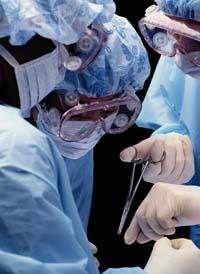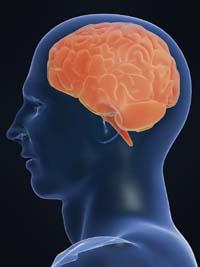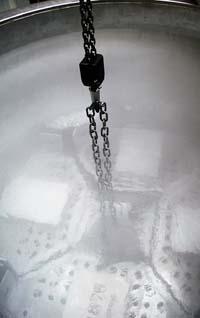Hibernation to pause
2007/12/01 Galarraga Aiestaran, Ana - Elhuyar Zientzia Iturria: Elhuyar aldizkaria

In the intervention of the aorta artery, a deep hypothermia is first induced to the patient. Deep hypothermia is similar to hibernation, decreasing body temperature when hibernating and significantly decreasing blood circulation, breathing, and brain activity. A similar effect can be achieved with a strong body cooling: the decrease in the patient's temperature reduces biochemical reactions and metabolic activity, so the patient needs less oxygen than the normal temperature.
This is a remarkable advantage in cardiac surgery operations and similar long and complex operations. In fact, in these operations the circulation is interrupted, putting in danger the organs that need much oxygen. For example, when the body is at normal temperature, if the brain gets little oxygen, the neurons die.
In hypothermia, the brain needs much less oxygen than normal and the rest of organs. In other words, the organs are, in some way, protected from the damage caused by the lack of oxygen. Surgeons take advantage of this protection to operate.
Thus, before starting the operation, surgeons cool the patient's body up to 15ºC. For this purpose, they pass the blood of the patient through an external circuit to the body. The circuit is similar to a centrifugal pump and fulfills the lung function when performing the gaseous exchange. In addition, it allows the exchange of heat.
Therefore, in the circuit the blood is cooled and the body temperature of the patient decreases with the blood cooled. Then, once the operation is finished, they use the same circuit to heat the blood and regenerate the temperature.

With the body at 15ºC the heart can be kept standing for 30-45 minutes, without risk of discomfort in the brain. From there, however, the risk of adverse effects increases, so surgeons do not usually run danger.
However, surgeons have a trick to lengthen the gap: making a sort of bridge they use another artery to carry blood to the brain. Thanks to this, they have a period of one hour to operate, without risk of neurological damage.
Stop time
However, scientists would want to further expand the time that the body spends sleeping, hibernating. In this way, the safe time of operation would be increased. In addition, a patient who hopes to be operated on death or death would not have so much haste to wait for the right time. And, going further, astronauts could travel at very long distances, without suffering damage to the organism.
But is it possible to achieve this? In a few cases, it seems like yes, hibernating people is not a dream. In these cases, doctors believe that people hibernated, they have no other explanation.

Last year, for example, in Japan, a man named Mutsutaka Uchikoshi went to the mountain with friends and was lost. They found him twenty-four days later. He hardly had a pulse and his body was at 22ºC, but he was alive. He was transferred to the hospital and it was confirmed that his body did not suffer significant damage. According to the doctors, in those days it seemed that the metabolism had paralyzed as if it had been hibernating, which allowed it to survive.
What happened in Uchikoshi is surprising, but with more similar cases, scientists believe it is possible to hibernate patients.
Mechanisms of hibernardo
To get people hibernated, researchers treat them in different ways. One of the tracks is related to the thermoregulation center. Only hot blood animals have a thermoregulation center located in the cerebral hypothalamus, which is responsible for maintaining stable body temperature.
Hibernating animals experience changes in the thermoregulation center, as well as people and other animals, but only when they have a fever. The regulation involves various neurotransmitters (catecholamines, serotonin, dopamine, GABA, glutamate, acetylcholine), but scientists still do not know how they act. Therefore, for the moment it seems very difficult to hibernate by influence in the thermoregulation center.
For other researchers, the key is the decrease in ambient temperature. For many hibernating animals, the decrease in ambient temperature is a sign to enter hibernation. Its body temperature decreases with that of the environment and the metabolism decreases with body cooling. However, both phenomena do not go parallel: before the body cools much, the metabolism decreases considerably.

If anyone is placed in a very cold environment, however, it does not start hibernating, it gets into hypothermia. In the early stages of hypothermia, the body launches various protection mechanisms, such as chills. However, when the body temperature drops to 30-32ºC, the chills stop, while at 28ºC the heart proceeds to the fibrillation and to the interruption of the breath towards 23ºC. Therefore, the reduction of the temperature is also not the appropriate way to get the hibernation status.
On the other hand, hibernating animals, to protect themselves from damage that may result from the decrease in body temperature, have a specific metabolic and physiological regulation. One of the keys to this regulation is that when hibernating the body uses lipids to obtain energy instead of carbohydrates. It seems that this is related to the hormone leptin, since the fatty acids move according to it. Scientists have tried to hibernate other species based on it, but have not obtained good results.
In search of the hibernation key, researchers have also looked at the genes. Specifically, genes that are expressed at the time of hibernation in hibernating animals have been investigated. As these genes are also present in the human genome, they have studied the hypothesis that it would be possible to hibernate with them.
However, they still have much to investigate. In fact, when you start hibernating a series of consecutive mechanisms are triggered in different systems: blood circulation, respiratory system, brain... All systems that affect homeostasia should be taken into account, know the genes involved and their expression. For the time being too complex.
Hibernation of mice and pigs

Although they have not found the hibernation mechanism to people, they have obtained good results in numerous experiments with laboratory animals. For example, two years ago they published in the journal Science that mice were hibernated for more than six hours.
The experiment was conducted at the United States Cancer Research Center, Fred Hutchinson. Mice were placed in a room with hydrogen sulfide in the air (80 ppm of hydrogen sulfide). In fact, hydrogen sulfide is also produced in animal and human organisms, and researchers believe it participates in the regulation of body temperature and metabolism.
After a few minutes breathing air with hydrogen sulfide, the mice stopped moving and seemed to have lost consciousness. Instead of breathing 120 times per minute, they only took 10 times per minute and, when the ambient temperature dropped to 13 °C, the body temperature decreased from 37 to 11 °C.
In this situation, six hours remained and were recovered. To do this, it was enough to introduce hydrogen sulfide free air into the chamber. And they showed that the mice had not suffered any negative effects.
Before performing the experiment with the mouse, they also managed to hibernate other animals, such as worms and zebra fish. In all of them, gases such as hydrogen sulfide and carbon monoxide were used. These gases are similar to molecular oxygen and bind to the same receptors. This makes it difficult to use oxygen. But it seems that this causes the metabolism to slow down, which leads the body to a situation similar to hibernation. The next step is to test the technique in larger mammals.

Last year, another step was taken at the General Hospital of Massachusetts. The experiment was carried out with pigs and, instead of using gases, a liquid was used, a cold saline solution. With this solution, the blood of pigs was replaced.
The body temperature of the animals decreased to 10ºC, had no pulse and the brain had no electrical activity either. After three hours of permanence in this situation, they were given the blood. Immediately the heart was set in motion and all organs were recovered. According to researchers at the Massachusetts General Hospital, there are no major obstacles to using this technique in people.
In one way or another, for the moment, to hibernate people is a dream. Until when? We do not know, but at least the researchers do not sleep and it is possible that the secret may be revealed shortly.


Gai honi buruzko eduki gehiago
Elhuyarrek garatutako teknologia






